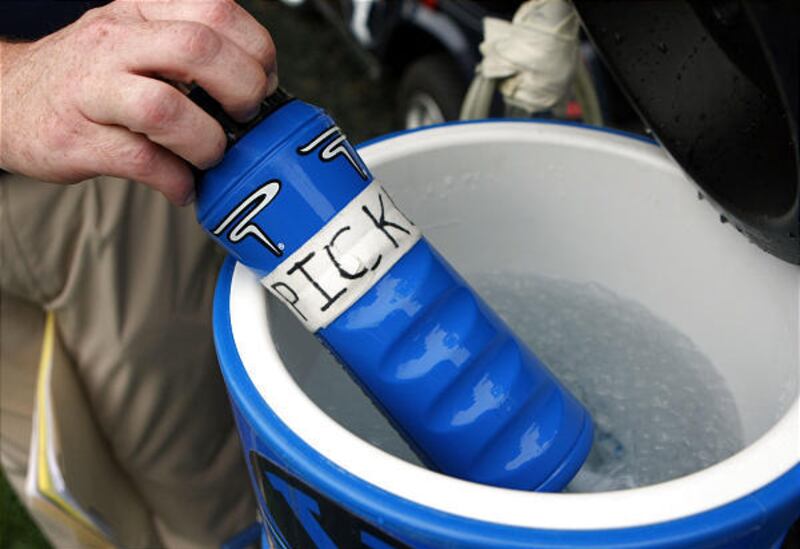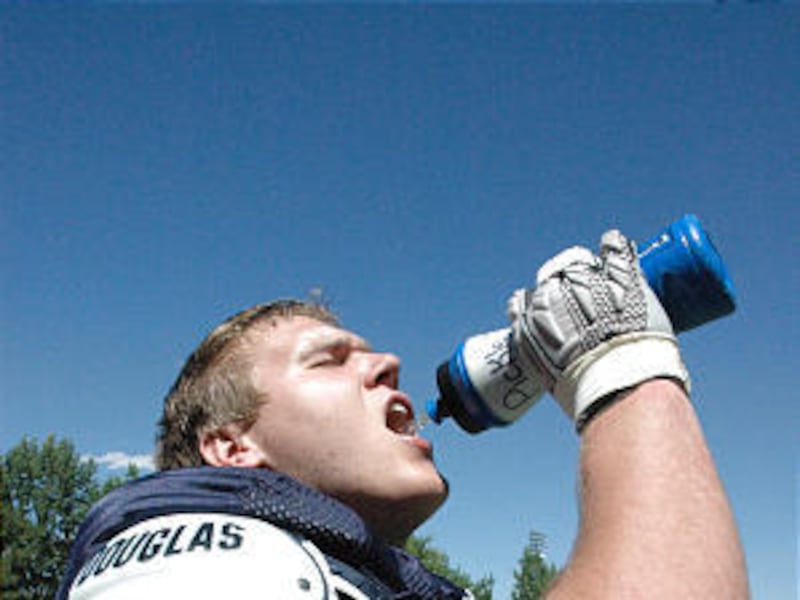PROVO — By the second quarter of Matt Reynolds' second BYU football game, he was hot, sweaty and cramping. Badly.
"They brought me off to the side and loaded me up on pickle juice," the offensive lineman said. "I didn't really want to at first, but it seems to really help, so now I'll take it pre-emptively."
Starting his third season with the Cougars, Reynolds has become one of the team's top pickle juice drinkers.
"For some reason, I've been the one that cramps up a lot, so I've had to guzzle my fair share," he said.
It's not that he likes the taste; actually, it gets worse the more he drinks, but there's something in the briny green liquid that stops muscle cramps faster than sports drinks and more effectively than water alone.
In fact, for 11 years, the football team has been gulping down the dill pickle juice, thanks to former head trainer George Curtis, who started the tradition.
"It was dramatic, the results we were seeing," said current head trainer Kevin Morris. "Since we've been using it — knock on wood — we've only had about two or three guys we've had to IV. Before that, in the first three or four games, we were doing two or three IVs a game because they were cramping so bad."
Yet, until a recent BYU study about pickle juice's effects on cramps, no one really knew why it worked.
"It was one of those cases where the science kind of followed the practice," said Ty Hopkins, BYU exercise science professor and co-author on the study.
The traditional explanation is that the salt and electrolytes in pickle juice helped restore balance to a dehydrated, out-of-balance body, thus eliminating the cramp.
"The problem with that is ... the body can't absorb the salts out of the juice and have it physiologically do anything in that short period of time," Hopkins said.
But Kevin Miller, then a Ph.D. student at the Y., knew the football team was using pickle juice religiously. Was it a placebo effect, or did it really possess some cramp-relieving ability?
For his dissertation, Miller studied 10 male subjects who exercised until they were mildly dehydrated. After exercising, they experienced two electrically induced cramps on their big toe and were given pickle juice, water or nothing to drink. Participants wore nose plugs and were told not to make faces, so the researcher wouldn't know what they were drinking.
For subjects who drank pickle juice, the cramp was gone in 85 seconds, while water took 134 seconds. Drinking nothing meant the cramp lasted for 153 seconds.
Blood and urine tests found no change in sodium, potassium, magnesium or other levels, which meant that pickle juice was not being absorbed into the blood and reducing the cramp by adjusting electrolyte levels.
Based on the double-blind study, Miller wrote that something in the pickle juice (most likely acetic acid) must have caused a neurological response in the mouth, which then told the brain to stop the cramp.
"Since it's not in the stomach, if it is actually activating nerves in the mouth ... you might not even have to swallow the pickle juice to get the effect," he said. "Some people say, 'Pickle juice is gross, I'd rather have the cramp.' But if you don't have to drink it, that might be another issue altogether."
Miller, now a professor at North Dakota State University, had his findings published in "Medicine & Science in Sports & Exercise," the official journal of the American College of Sports Medicine, and is working on several more pickle-juice papers.
If the "swishing" theory proves effective (as it already has with water and carbohydrates in other studies), players like Eathyn Manumaleuna would gladly trade in a cupful for a mouthful.
"I've never played a game without drinking pickle juice," the defensive lineman said.
It's still gross, he added, but it works — pickle juice before a game means no cramps.
Other players vow they'll never get used to the "acquired taste" and that they'll chug water instead.
But once they come off the game field with a cramp, the arguing is over, Morris said. They're drinking pickle juice, followed by plenty of water.
During preseason practices, the team drinks nearly five gallons a week, but come September, the Cougars gulp down three to four gallons a game, Morris said.
Ruby River in Provo provides juice for home games, and when the team travels, they ask their hotel to save any dill pickle juice, Morris said. One hotel didn't quite understand and provided a crystal punch bowl full of the green juice with dinner.
Trainers quickly explained the juice is for game day, when everybody gets a cold four ounces before warm-ups. Some guys drink more before kick-off, then it's bottoms-up again at halftime.
In fact, pickle juice is so "popular" that the team had to come up with a special hand sign — a water-bottle squeezing motion near the face — to call for it on the field.
Morris has even volunteered pickle juice to a downed, cramping opponent, which, to this point, has been quizzically refused.
"So I'm offering it," he said with a smile. "I'm not just keeping it as our little secret."
The Cougars aren't the only ones who use it, though, he said. Morris has former gridders now in the NFL who say their teams pass around the briny beverage, and Manumaleuna said he first tried pickle juice while playing for Timpview High School. Morris mentions stories he's heard about pioneers who drank it on lunch breaks for work in the fields, which made it all the more surprising to Miller that no one else had really scientifically studied pickle juice and cramps — until now.
"I think what (this study) has done is put some science behind it," said Gary Mack, co-author and BYU professor of exercise science. "It's the same thing with most sports and athletics; coaches and trainers find stuff that works but nobody knows why. Kevin (Miller) has finally provided them some rational explanation for pickle juice."
e-mail: sisraelsen@desnews.com



